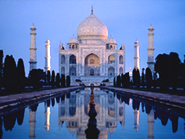Last month, we visited the Taj Mahal. Above is a picture; it is an iconic monument, one of the wonders of the ancient and modern world. ‘Taj Mahal’ means ‘ crown palace’ , it is a white marble mausoleum with a mosque to the right and a guest house to the left built beside the Yamuna river in the city of Agra, about 150 kilometers from Delhi in Northern India. That is a description, but it is as useful as saying the Mona Lisa is a painting – accurate but so inadequate.
History  ( fairly well authenticated ) says that the Taj Mahal was built in between 1632 and 1654 by the 5th Mogul Emperor, Shah Jahan, as a tomb for his beloved wife Mumtaz Mahal, who died in childbirth in 1630. Her dying wish was that he build a tomb to her memory, such as the world has never seen. He did.
( fairly well authenticated ) says that the Taj Mahal was built in between 1632 and 1654 by the 5th Mogul Emperor, Shah Jahan, as a tomb for his beloved wife Mumtaz Mahal, who died in childbirth in 1630. Her dying wish was that he build a tomb to her memory, such as the world has never seen. He did.
So what? History. A long time ago. Yawn.
Well, wait and follow us. If you were to visit, you would come into it through a rather unprepossessing entrance, having fought your way there on the Indian roads, filled with auto rickshaws, bicycles (with two or three people perched on them), mopeds, cars, buses, goats and cows all competing for the space on the road with your car. The air is dusty, the sounds of car horns are everywhere. You enter a courtyard from theSouth, with green lawns and red sandstone. It is more peaceful. The gate above you is over twenty meters high, with a design of twenty two brass globes on top, in two rows of eleven. Each globe represents one year of construction. You can’t see the main building until you go through the gate, and then – there it is, framed by the archway, set perfectly like a diamond in the earth. Almost too perfect, symmetrical from any side.
It is heart achingly beautiful, like a childhood dream, perfect and impossible to recapture afterwards. It is like a jewel, with both sunlight and moonlight equally reflected by the pale marble walls.
Nearly 400 years after being built, it stands unaffected by time or weather. It is built of white Makrana marble , the hardest in the world, taken from quarries one hundred and forty miles away to the West, A team of twenty thousand workmen using fifteen hundred elephants labored for twenty two years. Because Makrana marble is so hard, all the decorative and delicate inlay work with semi precious stones had to be done by hand chiseling the marble, cutting the semi precious stones to fit and then gluing them in. Very few craftsmen are left who are still able to do this.
OK, but what has this to do with coaching?
Because it is about values, goals and beliefs. We can learn something about coaching from this. Th
It started as a dream, and was made into reality. By whom? By people whose names are not well recorded in record books: the architects. it may have been one man’s dream, but there were some immensely intelligent people who made it real. (History records Mir al-Karim and Makramat Khan as the principal architects). It needed thought, work, great skill to make the vision reality. Architects, like coaches, are seldom remembered, yet their contribution is immense.
Something else – planning and action also needs careful risk assessment, In the Taj Mahal the four towers one at each corner, are angled slightly outwards, away from the main building, so that in case of earthquakes they would fall away from the main structure. The foundations were made of oak. One hundred and fifty well were drilled underneath to keep it moist and flexible enough so it did not crack, or rot. Dreams need secure foundations.
Love, power, risk, commitment, perseverance, beauty, design and legacy – they are all there. These are things that should concern us as coaches.
We often say that the basis of a full life is meaning, achievement, happiness and leaving a legacy. It looks like the Emperor ( and we hope his architects) had a very full life. And if he had an equivalent of a coach four hundred years ago, that coach would have been supporting him to the utmost.
This post is also available in: InglésPortugués, Brasil



